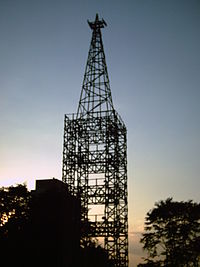
An aerial tramway, aerial tram, sky tram, aerial cablecar, aerial cableway, telepherique, or seilbahn is a type of aerial lift which uses one or two stationary ropes for support while a third moving rope provides propulsion. With this form of lift, the grip of an aerial tramway cabin is fixed onto the propulsion rope and cannot be decoupled from it during operations. In comparison to gondola lifts, aerial tramways generally provide lower line capacities and higher wait times.

Nevado del Ruiz, also known as La Mesa de Herveo is a volcano on the border of the departments of Caldas and Tolima in Colombia, about 129 km (80 mi) west of the capital city Bogotá. It is a stratovolcano composed of many layers of lava alternating with hardened volcanic ash and other pyroclastic rocks. Volcanic activity at Nevado del Ruiz began about two million years ago, during the Early Pleistocene or Late Pliocene, with three major eruptive periods. The current volcanic cone formed during the present eruptive period, which began 150,000 years ago.

A gondola lift is a means of cable transport and type of aerial lift which is supported and propelled by cables from above. It consists of a loop of steel wire rope that is strung between two stations, sometimes over intermediate supporting towers. The cable is driven by a bullwheel in a terminal, which is typically connected to an engine or electric motor. It is often considered a continuous system since it features a haul rope which continuously moves and circulates around two terminal stations. In contrast, an aerial tramway operates solely with fixed grips and simply shuttles back and forth between two end terminals.

Manizales is a city in central Colombia. It is the capital of the Department of Caldas, and lies near the Nevado del Ruiz volcano.

Armenia is the capital of Quindío Department in the South American country of Colombia. Armenia is a medium-sized city and part of the "coffee axis" along with Pereira and Manizales. It's one of the main centers of the national economy and of the Colombian coffee growing axis. As a result, the historic center of Armenia was named as part of the "Coffee Cultural Landscape" of UNESCO World Heritage Site in 2011.

Ibagué is the capital of Tolima, one of the 32 departments that make up the Republic of Colombia. The city is located in the center of the country, on the central mountain range of the Colombian Andes, near Nevado del Tolima. It is one of the most populous cities in the country, with a population of 492,554, making it the eleventh most populous in Colombia, and with a population of 529,625 in the municipality. It was founded on 14 October 1550, by the Spanish captain Andrés López de Galarza. The city of Ibagué is divided into 13 communes and the rural area has 17 corregimientos. As the capital of the department of Tolima the city hosts the Government of Tolima, the Departmental Assembly, and the Attorney General's Office. It is the main epicenter of political, economic, administrative, business, art, culture, and tourism activities in the area.

Pereira is the capital city of the Colombian department of Risaralda. It's located in the foothills of the Andes in a coffee-producing area of Colombia officially known as the "Coffee Axis". Pereira, alongside the rest of the Coffee Axis, form part of UNESCO World Heritage Site known as the "Coffee Cultural Landscape of Colombia". It's the most populated city in the Coffee Axis. Pereira is also part of the Central West Metropolitan Area, which has 735.769 residents and is composed of Pereira and the neighboring cities of Dosquebradas and La Virginia. It's considered the most important city in the "Coffee Axis" from a geopolitical and economic standpoint.
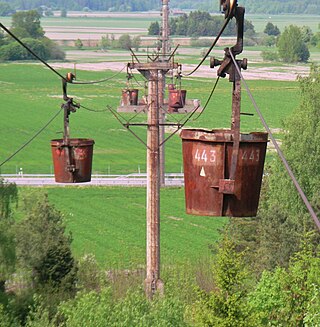
A material ropeway, ropeway conveyor is a subtype of gondola lift, from which containers for goods rather than passenger cars are suspended.

Pijao is a municipality in the south-eastern part of the department of Quindío, Colombia. The town is located 31 km south of the departmental capital Armenia in the Colombian coffee growing axis, it's part of the "Coffee Cultural Landscape" UNESCO World Heritage Site in 2011.
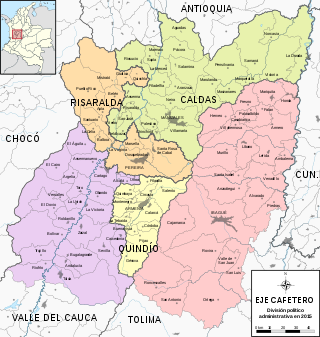
The Colombian coffee region, also known as the Coffee Triangle is a part of the Paisa region in the rural area of Colombia. It is famous for growing and producing the majority of Colombian coffee. There are four departments in the area: Caldas, Quindío, Risaralda and Tolima. The most visited cities are Manizales, Armenia, Pereira, and Ibagué.

The Nevado del Tolima is a Late Pleistocene to recently active andesitic stratovolcano located in the Tolima department, Colombia. The volcano lies south of Nevado del Ruiz volcano and is situated within the Los Nevados National Natural Park. The volcano, whose most recent activity dates to 1943 and last major eruption around 3600 years ago, overlies the Eocene El Bosque Batholith, dated at 49.1 ± 1.7 Ma.

Viterbo is a town and municipality in the Colombian Department of Caldas. Formally constituted as a municipality on December 31, 1951, it was founded on April 19, 1911 by Presbítero Nazario Restrepo Botero. The current mayor is Jhon Mario Giraldo Arrubla. They call it "El Paraiso Turistico de Caldas" (The Touristic Paradise of The Colombian Department of Caldas. It is known as this due to its all year through warm climate, Villas, Farms and Condominiums around the surrounding land, and the welcoming people of the 'Viterbeños'.
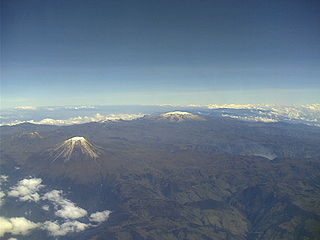
Los Nevados National Natural Park is a national park located in the Cordillera Central of the Colombian Andes. The park surrounds the northern volcanic complex formed by Nevado del Ruiz, Nevado del Tolima, Nevado de Santa Isabel, the paramillos of Cisne, Santa Rosa and Quindío and the Cerro Bravo and Cerro Machín.
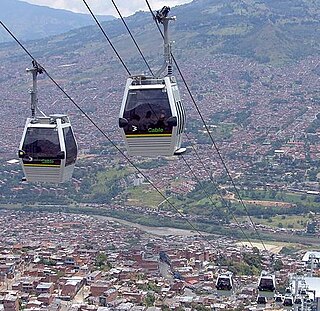
Metrocable is a gondola lift system implemented by the City Council of Medellín, Colombia, with the purpose of providing a transportation service that complements the Medellín Metro. It was designed to reach some of the city's informal settlements on the steep hills that mark its topography. It is largely considered to be the first urban cable propelled transit system in South America. The transportation infrastructure is already established and has been in service since 2004.

The Forsby-Köping limestone cableway, commonly referred to in Swedish as Kalklinbanan, was a 42 km aerial tramway running from Forsby in Vingåker municipality to industrial town Köping in central Sweden. Its final destination is the factory at the port of Köping, where cement was manufactured until 1978, and later various limestone derivatives. The cableway was Europe's longest at the time of construction. It was later superseded by a handful of longer cableways, notably the Norsjö aerial tramway, all of which were demolished during the 1960s–1980s. It was taken out of service in 1997 but kept in working order. By that time all longer industrial cableways had been demolished making it at present the world's longest cableway in working order.

Torre de Herveo, also known as Torre del Cable, is a wooden Colombian lattice tower which was the tallest of the support towers of the Manizales - Mariquita Cableway. The Torre de Herveo was in service from 1922 to 1961. It only serves as a monument and as transportation today. The engineer who built the tower was James Lindsay. Wood was chosen as the building material for the tower and was built with approximately 1,470 blocks of timber from the wood of Guaiac, Mahogany, Bay and Comino trees.

The Antioquia Railway is a historic railway system in Colombia of freight and passenger trains that joined much of the central regions of the Antioquia department along the Magdalena river, and ultimately extended to provinces located south of the department, including Caldas and the Valle del Cauca. It took 55 years to build: from 1874 to its opening on 7 August 1929. The Antioquia Railway was for decades an important link among regions that had previously been isolated and was a large contributor to economic development in the region. With the construction of alternative forms of transportation, especially roads, the use of the train declined in the 20th century. The railway was officially sold in 1961.
The 1955 Campeonato Profesional was the eighth season of Colombia's top-flight football league. 10 teams compete against one another and played each weekend. Independiente Medellín won the league for 1st time in its history after getting 44 points. Atlético Nacional, the defending champion, was 2nd with 39 points.
Bahareque, also spelled bareque, is a traditional building technique used in the construction of housing for indigenous peoples. The constructions are developed using a system of interwoven sticks or reeds, with a covering of mud, similar to the systems of wattle and clay structures seen in Europe. This technique is primarily used in regions such as Caldas, which is one of the 32 departments of Colombia.
